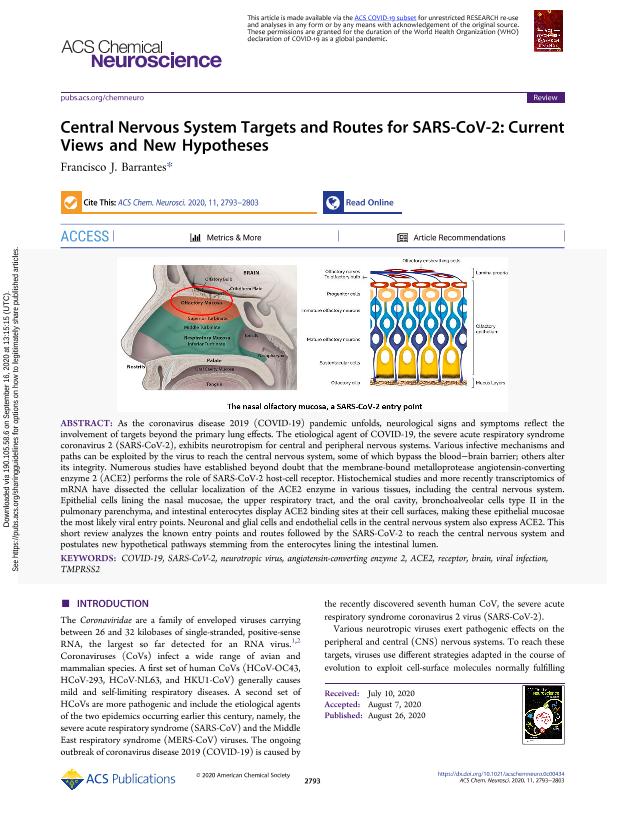Mostrar el registro sencillo del ítem
dc.contributor.author
Barrantes, Francisco Jose

dc.date.available
2020-11-25T17:17:54Z
dc.date.issued
2020-09
dc.identifier.citation
Barrantes, Francisco Jose; Central Nervous System Targets and Routes for SARS-CoV-2: Current Views and New Hypotheses; American Chemical Society Inc; ACS Chemical Neuroscience; 11; 18; 9-2020; 2793-2803
dc.identifier.uri
http://hdl.handle.net/11336/118977
dc.description.abstract
As the coronavirus disease 2019 (COVID-19) pandemic unfolds, neurological signs and symptoms reflect the involvement of targets beyond the primary lung effects. The etiological agent of COVID-19, the severe acute respiratory syndrome coronavirus 2 (SARS-CoV-2), exhibits neurotropism for central and peripheral nervous systems. Various infective mechanisms and paths can be exploited by the virus to reach the central nervous system, some of which bypass the blood-brain barrier; others alter its integrity. Numerous studies have established beyond doubt that the membrane-bound metalloprotease angiotensin-converting enzyme 2 (ACE2) performs the role of SARS-CoV-2 host-cell receptor. Histochemical studies and more recently transcriptomics of mRNA have dissected the cellular localization of the ACE2 enzyme in various tissues, including the central nervous system. Epithelial cells lining the nasal mucosae, the upper respiratory tract, and the oral cavity, bronchoalveolar cells type II in the pulmonary parenchyma, and intestinal enterocytes display ACE2 binding sites at their cell surfaces, making these epithelial mucosae the most likely viral entry points. Neuronal and glial cells and endothelial cells in the central nervous system also express ACE2. This short review analyzes the known entry points and routes followed by the SARS-CoV-2 to reach the central nervous system and postulates new hypothetical pathways stemming from the enterocytes lining the intestinal lumen.
dc.format
application/pdf
dc.language.iso
eng
dc.publisher
American Chemical Society Inc

dc.rights
info:eu-repo/semantics/openAccess
dc.rights.uri
https://creativecommons.org/licenses/by-nc-sa/2.5/ar/
dc.subject
ACE2
dc.subject
ANGIOTENSIN-CONVERTING ENZYME 2
dc.subject
BRAIN
dc.subject
COVID-19
dc.subject
NEUROTROPIC VIRUS
dc.subject
RECEPTOR
dc.subject
SARS-COV-2
dc.subject
TMPRSS2
dc.subject
VIRAL INFECTION
dc.subject.classification
Neurociencias

dc.subject.classification
Medicina Básica

dc.subject.classification
CIENCIAS MÉDICAS Y DE LA SALUD

dc.title
Central Nervous System Targets and Routes for SARS-CoV-2: Current Views and New Hypotheses
dc.type
info:eu-repo/semantics/article
dc.type
info:ar-repo/semantics/artículo
dc.type
info:eu-repo/semantics/publishedVersion
dc.date.updated
2020-11-25T16:07:20Z
dc.identifier.eissn
1948-7193
dc.journal.volume
11
dc.journal.number
18
dc.journal.pagination
2793-2803
dc.journal.pais
Estados Unidos

dc.description.fil
Fil: Barrantes, Francisco Jose. Pontificia Universidad Católica Argentina "Santa María de los Buenos Aires"; Argentina. Consejo Nacional de Investigaciones Científicas y Técnicas. Oficina de Coordinación Administrativa Houssay. Instituto de Investigaciones Biomédicas. Universidad de Buenos Aires. Facultad de Medicina. Instituto de Investigaciones Biomédicas; Argentina
dc.journal.title
ACS Chemical Neuroscience
dc.relation.alternativeid
info:eu-repo/semantics/altIdentifier/doi/http://dx.doi.org/10.1021/acschemneuro.0c00434
dc.relation.alternativeid
info:eu-repo/semantics/altIdentifier/url/https://pubs.acs.org/doi/10.1021/acschemneuro.0c00434
Archivos asociados
